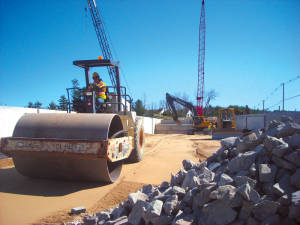Building a solid Naples Causeway bridge to last
Editor’s Note: On April Fools’ Day, the non-real is presented to us as reality. Employees at the Maine Department of Transportation (MDOT) Naples field office were asked what material they would use to build an arch bridge – if the sky was the limit, the budget was vast, and engineers and physicists worked together to make the impossible do-able. Just to clarify to the reader, the Bay of Naples Bridge is a concrete bridge. The bridge will not be constructed with the other materials mentioned in this article.
By Dawn De Busk
Staff Writer

On Tuesday morning, crews from R.J. Grondin & Sons, Inc., put in the drainage for the new section of Route 302 as it connects to the future Bay of Naples Bridge. (De Busk Photo)
NAPLES – Gold is the answer: Let’s make a bridge out of solid gold.
But, gold would be too heavy an element to use for an arched bridge, Maine Department of Transportation (MDOT) Assistant Engineer Eric Rudolph said. How about silver, he asked.
As Rudolph and MDOT Resident Engineer Craig Hurd pondered what else to use to build the bridge, Rudolph declared platinum might be a more mutable and lighter weight material.
“Platinum – that would be a really shiny bridge,†Hurd responded.
Project Technician Lisa Cole said her imaginary bridge would be constructed from cheese cake. She would enlist scientists to discover a way to harden the Jell-O like texture of the cheese cake so it would support the weight of motor traffic. And, the Causeway bridge would smell as delicious as they day the mixture was poured into an arched shape.
Jeff Simpson, the superintendent on this job for general contractor Wyman & Simpson Inc., said concrete topped his list as the best material for this arched bridge.
Concrete “is the preferred material. It’s sturdy. It’s durable. It lasts. And, it’s relatively easy to work with,†he said.
“It can form into many shapes as you can tell by looking at the bridge now,†he said.
In the past six months, concrete has been placed to form a hollow rectangle (the coffer dam), a square (the footer), two standing rectangles (the abutments), and the fan-shaped arch.

A Wyman & Simpson, Inc. crane delivers a generator to the construction workers on the Bay of Naples Bridge project on Tuesday. (De Busk Photo)
About six weeks from now, the Bay of Naples Bridge will be completed, ready for a May 18 ribbon-cutting ceremony and accompanying festivities.
Since the bid was awarded to Wyman Corp. in September 2010, Simpson and the three state transportation department employees have been working together at the MDOT offices, located on the Causeway.
While the temporary field offices are an important arm of the project and sometimes a hub of activity, the desks are most often empty – because the majority of the work is taking place outdoors on the construction site.
On Tuesday morning, Cole was bundled against the north wind and monitoring the road-drainage work being done by a subcontractor on the project.
Cole has worked for MDOT for 18 years – 15 of those on 40 different road and highway construction projects; and the last three years on bridge construction projects.
She said she was glad the subcontractor R.J. Grondin & Sons has returned to the construction site after a wintertime hiatus.
Grondin will be completing the new section of Route 302 – the elevated roadway that will meet the new bridge. That road work has the same mid-May completion date as the bridge.
“Now, that Grondin is back, there’s even more activity on the Causeway,†she said.
She added it will get busier as the countdown to the deadline for completing the bridge nears.
Before work started on the Naples project, Cole was assigned to a construction job in Standish: the replacement of Whites’ Bridge.
There are some familiar faces – people involved in both the bridge projects in both Maine towns, she said.
As he does now, Hurd, a 22-year employee of MDOT, served as resident engineer on that year-long bridge replacement job. Like the Bay of Naples Bridge, the structure on White’s Bridge Road is made from primarily concrete.
Also, in Standish, Wyman Inc. was awarded the bid for the infrastructure improvement – with Simpson in the role of superintendent.
Several people on the Naples’ bridge crew have had a hand in completing both projects, Simpson said.
On numerous occasions, he has referred to the bridge crew “as a great bunch of guys who work well together.â€
“Some of them have worked together for a while,†he said.
Simpson recalled working on his first bridge construction job, “I was probably 25 years old. It was on Desert Island.â€
His grandfather, Walworth Simpson along with A.J. Wyman started the business in 1924; and, Doug Hermann purchased the company in 1991, according the corporation’s website.
“He was just a nice old man, when I knew him,†he said, adding his grandfather was known by the nickname, “Sim.â€
“He had a good reputation in the construction industry, and he was well liked and respected, even by his competitors,†Simpson said.


